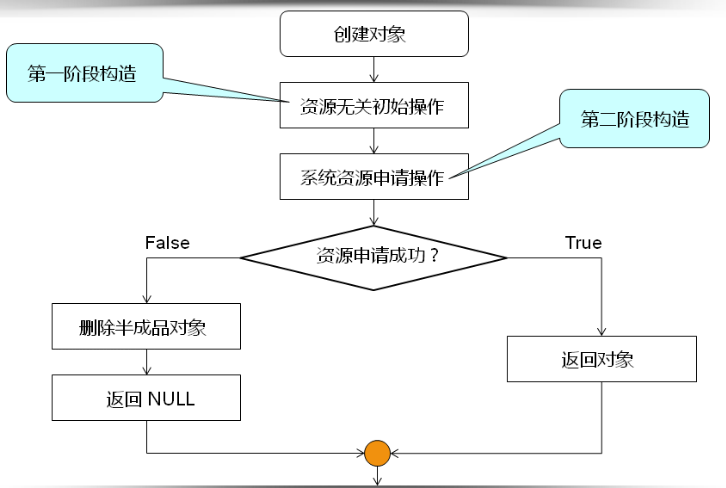二阶构造
工程开发中的构造过程可分为
-资源无关的初始化操作
不可能出现异常情况的操作
- 需要使用系统资源的操作
可能出现异常情况,如:内存申请,访问文件

二阶构造示例一
class TwoPhaseCons{
private:
TwoPhaseCons(){ //第一阶段构造函数,就是用C++中的构造函数。
}
bool construct(){ //第二阶段构造函数,一个普通的成员函数。
.......
return true;
}
public:
static TwoPhaseCons* NewInstance(); //对象创建函数
}
注意:第一阶段的构造函数放在了private下面,就意味着它不能被外界调用了。即不能通过类名直接来定义一个对象了。
二阶构造示例二
TwoPhaseCons* TwoPhaseCons:: NewInstance() {
TwoPhaseCons* ret = new TwoPhaseCons(); //在堆空间中创建一个对象,在创建对象的时候,构造函数肯定被调用。即第一阶段
//若第二阶段构造失败,返回NULL
if( !(ret && ret->construct())){
delete ret;
ret = NULL;
}
return ret;
}
二阶构造函数初探:
#include <stdio.h>
class TwoPhaseCons
{
private:
TwoPhaseCons() // 第一阶段构造函数
{
}
bool construct() // 第二阶段构造函数
{
return true;
}
public:
static TwoPhaseCons* NewInstance(); // 对象创建函数
};
TwoPhaseCons* TwoPhaseCons::NewInstance()
{
TwoPhaseCons* ret = new TwoPhaseCons();
// 若第二阶段构造失败,返回 NULL
if( !(ret && ret->construct()) )
{
delete ret;
ret = NULL;
}
return ret;
}
int main()
{
//TwoPhaseCons obj; //编译会出错,因为构造函数被定义成私有的,不能在类的外部直接调用(main 又不是类的成员函数)
TwoPhaseCons* obj = TwoPhaseCons::NewInstance();
printf("obj = %p
", obj);
delete obj;
return 0;
}
二阶构造的意义在于:要么得到一个合法可用的对象,要么返回一个空。二阶构造用于杜绝半成品的对象。
将数组类进行改写:
IntArray.h
#ifndef _INTARRAY_H_
#define _INTARRAY_H_
class IntArray
{
private:
int m_length;
int* m_pointer;
IntArray(int len);
bool construct();
public:
static IntArray* NewInstance(int length);
int length();
bool get(int index, int& value);
bool set(int index ,int value);
~IntArray();
};
#endif
IntArray.cpp
#include "IntArray.h"
IntArray::IntArray(int len)
{
m_length = len;
}
bool IntArray::construct()
{
bool ret = true;
m_pointer = new int[m_length];
if( m_pointer )
{
for(int i=0; i<m_length; i++)
{
m_pointer[i] = 0;
}
}
else
{
ret = false;
}
return ret;
}
IntArray* IntArray::NewInstance(int length)
{
IntArray* ret = new IntArray(length);
if( !(ret && ret->construct()) )
{
delete ret;
ret = 0;
}
return ret;
}
int IntArray::length()
{
return m_length;
}
bool IntArray::get(int index, int& value)
{
bool ret = (0 <= index) && (index < length());
if( ret )
{
value = m_pointer[index];
}
return ret;
}
bool IntArray::set(int index, int value)
{
bool ret = (0 <= index) && (index < length());
if( ret )
{
m_pointer[index] = value;
}
return ret;
}
IntArray::~IntArray()
{
delete[]m_pointer;
}
main.cpp
#include <stdio.h>
#include "IntArray.h"
int main()
{
IntArray* a = IntArray::NewInstance(5);
printf("a.length = %d
", a->length());
a->set(0, 1);
for(int i=0; i<a->length(); i++)
{
int v = 0;
a->get(i, v);
printf("a[%d] = %d
", i, v);
}
delete a;
return 0;
}
小结:
构造函数只能决定对象的初始化状态
构造函数中初始化操作的失败不影响对象的诞生
初始化不完全的办成品对象是Bug的重要来源
二阶构造人为的将初始化过程分为两部分
二阶构造能够确保创建的对象都是完整初始化的